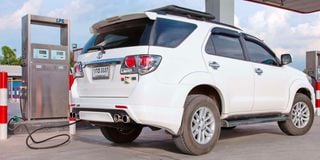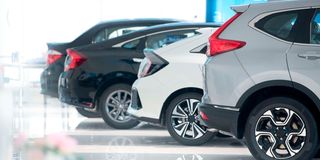Premium
Why converting your petrol-engined car to run on LPG is not a good idea

A vehicle fuels at a gas station.
What you need to know:
- Infrastructure development will focus on high-speed electrical charging hubs, not LPG stations.
Gavin,
I am an enthusiast of your column. I hope that you can take the lid off the pros and cons of using LPG to substitute gasoline in car engines. Due to high gasoline prices, I am thinking seriously about changing to LPG.
Philip N
The conversion of petrol-engined cars to run on LPG or a “dual” option of either fuel is technically quite simple, definitely reduces fuel consumption and produces less toxic exhaust fumes, and has been available worldwide for several decades. But it has never been widely used, and with the current and future emergence of electric vehicles (EVs) probably never will be.
The pros and cons will depend on your personal circumstances, location, motoring patterns and main objective. Clearly, the economics and logistics for a private motorist driving an average of 30kms per day in a remote area are vastly different from, say, an Uber driver running 300kms per day in Nairobi.
Most people considering the LPG option want to reduce their fuel costs, those and others may also want to reduce the pollution from their exhaust pipes. The upsides of LPG in both respects are clear, and can quite quickly off-set the conversion costs for motorists who do high mileages in locations with convenient refueling infrastructure.

For low mileage motorists, the conversion cost is the same, so the off-set takes longer and refueling can be extremely inconvenient. When in LPG mode, the engine will have noticeably less power. The valves will stay cleaner but wear faster. LPG systems are more sensitive to defects in the cooling system.
Most conversions are done by independent specialists. Motor manufacturers have not perceived nor embraced the market potential - EVs and hybrids will soon outperform all forms of liquid fuel engines in all respects. Infrastructure development will focus on high-speed electrical charging hubs, not LPG stations.
The cost saving at current prices is partly artificial. LPG, Petrol, Kerosene, and Diesel all come from crude oil and cost about the same to produce. Their pump price variations depend mostly on tax differentials based on their predominant usage. Tax rates can be changed (even inverted!) if different usage patterns evolve.
If it is old stock it is not a ‘new’ car

New cars for sale.
Gavin,
Do new cars age when they are still in a showroom?
William
Yes. All cars age with time, not just with use. New or used, they will stay in better condition if they are not left completely idle for long periods. If you park a car in your garage and cover it with a dust sheet for only a few months, many of its components will deteriorate and it will need diligent attention before you start using it again (perished rubber, brittle seals, flat-spotted tyres, rusty radiator, oil sludge, contaminated fuel and other fluids, jellified grease, dead battery, corroded shafts…)
And there are circumstances, even in the new car market, where new cars remain unsold and unused for several years. Even with the odometer still reading zero, they warrant a very thorough service of everything and even replacement or overhaul of some more perishable components.
Kenya has had its share of such vehicles. If understanding and recall serves me correctly, we had a batch of Peugeot 405s which had spent some years as surplus stock in Spain, and a consignment of “new” Lada Nivas that had been in storage elsewhere for so long that on arrival here they had to be sent to one of our assembly plants for a thorough strip down and partial remake.
The Niva, though it is a capable and stout-hearted little 4WD (except for its appalling steering geometry), has never been a hot seller here, and with the thorough revamp nothing much changed for better or worse after that batch.
The Peugeot, for many years Kenya’s best-selling brand, was another story. The 405 was first launched here with huge fanfare and prestige acclaim at a time new cars were not readily available. I later bought a used one from a Swedish dentist and it was excellent in power, comfort, reliability, utility and versatility (it even drove me down a dry river bed of rocks when I got lost on the way to Port Victoria for a tree-planting ceremony). Later, after the Spanish batch (which were also the wrong spec for this market) the 405’s reputation and resale value plunged to derisorily low levels. If you could distinguish between the French and Spanish ones, you could get potentially the best deal in the used car market.
Make your own conclusions.

A motorist pushes a car.
Moving a car without a push or a pull or a hill…or an engine
If my car splutters to a halt in a very dangerous position on a blind corner or even on a railway crossing, and will not restart and there is no one else around to help, should I just get out and start warning oncoming traffic, or is there any way a lone driver can move a stalled car to a safer place?
Kate
Short answer: Yes. Release the handbrake, engage gear, take your foot off the clutch, and turn the ignition key firmly to the start position. If the battery is working, the car will move, slowly and not for long, but for a few vital metres so you can steer it to a safer position.
Longer answer: Every car, petrol or diesel, also has a little electric “engine”. It is called the starter motor. Normally, when you turn the key fully, it switches on the ignition system and physically turns the engine with electrical power until the engine fires and petrol/diesel energy takes over. Normally, when you do this the gear is in neutral or you have your foot depressing the clutch pedal. Only when the engine has started do you engage gear and release the clutch, and the car moves under its own engine power.
But if the engine is not firing up (for whatever reason) and you turn the ignition key, the starter motor will still turn the engine, and if the car is in gear, that will turn the wheels and you will move.
To turn the engine with enough force and speed to fire up the engine, the starter motor needs to be quite powerful – it draws a huge load of electricity from the battery to do so, though only for a couple of seconds during normal starting. And that is enough power, in extremis, to move the whole car for at least several seconds on a relatively level surface.
Do not try to use the battery to drive the car in this way any further than absolutely necessary. The load is so high it will make the battery very hot very quickly, and use up its store of electricity at a prodigious rate. The heat generated by extremely high electrical loads and rapid discharge is the reason why you should never crank and engine for too long if it doesn’t fire up immediately.
In a hard-starting situation, crank for up to five seconds (and certainly not more than 10 seconds) just once or twice. Then leave a minute or two for the heat to dissipate before you try again. Do not crank for long periods nor in quick succession or you could “cook” the battery (permanent damage) and quickly flatten it.
Using the starter motor to move the whole car imposes even more extreme loads, and the technique should be used only in an emergency. The blind bend or the railway crossing, as you suggest. Or, most likely in our motoring conditions, if the car stalls in deep water that is starting to flow rapidly.
The starter motor technique could get you out, or at least into shallower water. The starter motor move can also be helpful when you are being towed out of a muddy ditch, but that’s another story.
Although Kenya does not have many railway crossings, and has relatively few trains, stalling on a level crossing is not unheard of and is a classic “what to do” situation, one of several that drivers would do well to consider in advance.
Stalled on a railway crossing and there is a train coming? If the train is really close, just get out and run. And with a little more advance thinking, if the train is coming from your side of the car, run towards it. If it’s coming from the other side, run at right angles from the track. That’s because when the train hits the car the wreckage is going to be moved in the direction the train is travelling. Do not run into that space.
If the train is still some distance away when you stall, try and re-start or use the starter-motor power. Handbrake off, gear engaged, foot off the clutch, turn the key. You can practice that in a safe space, so in an emergency you can act with confidence and know what is going to happen.
If you have some help for a push start but the pusher(s) are not strong enough to get the car up to speed, you can use the starter motor to help them. Use second or third gear. When the engine is not running the accelerator will of course have no effect, but the higher the gear the faster the starter motor will propel the car on the flat or slight downhill. Only first gear will have the power to drive it slightly uphill.
If ever you try to push a car on your own (driver’s door open, one hand on the steering wheel) do so with great circumspection and with one over-riding principle in mind: your full weight should at all times be either entirely outside the car so you can jump clear, or entirely inside the car so you can control it. Dividing your weight between inside and out greatly increases your chances of running yourself over. You need to be a stunt man (or woman) to try the solo doorway push and the key turn at the same time. It should only be a do-or-die option, and could well become a do-and-die.
The same principle applies to trying to stop a car that is starting to roll into motion with no one in the driver’s seat. Any attempted intervention should be completely in or completely out, not something in between.
And if that is not possible, don’t worry about what might happen to the car or the gate or the wall. If no human being is in danger, let it roll (especially if it is rolling backwards and an open door could knock you down)…and when you have finished holding your head in your hands, phone your insurance company.





